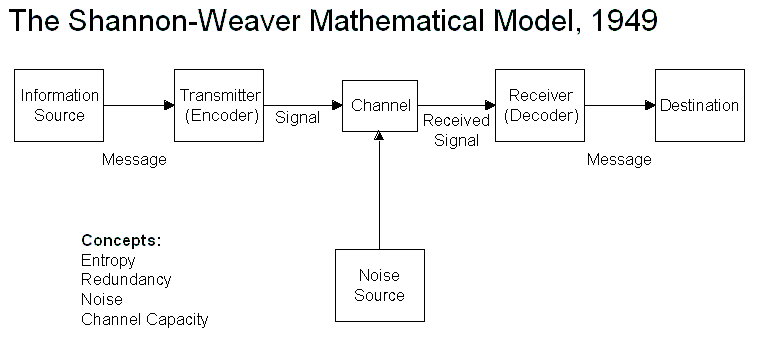Employed by american army, bell telephone labs. Employed by AA, wanted for refining communication systems. To make them more efficient. To find where communication broke down in the chain of command, where it was breaking and how it was breaking down. Mainly radio communication and radio they looked into. Initially limited to that, but it's been taken as a model for communication in the wider and social sense, visual and applied too.
Information source: (Voice Speaking)
Transmitter (Radio)
Channel: (Frequency)
Receiver: (Radio)
Destination: (Heard)
If you're gonna understand any communication act, you need to understand the act of it and the process of communication. Communication is more complex then that, and takes place in different mediums. There's five stages and at each of these points interference may occur/ break down.
The Shannon-weaver model for making Graphic Design, 2013:
Information source:
Client/Brief
Transmitter:
Designer (Encodes a message into the design)
Channel:
The design
Receiver:
Audience (Decodes the message in the design)
Destination:
Message communicated/ heard/ understood.
What if: Break down in communication in Graphic Design:
Information: Client/brief not explaining what they want clearly.
Transmitter: Designer not understanding the information/ communicates it ineffectively.
Channel: Printing, Coding issues, anything to impact distribution.
Receiver: Not clearly understanding the message been said. It's not noticed. (Problems relating to design problems in the previous sections, not encoded with a understanding of empathy and understanding of the audience and how they decode things.)
Destination: Not interested/ Zero communication
Noise source: Something that interferes with the communicative act, noise can happen at any stage of the process. An example been: Noise on the land (In context of telephone/radio) you can't hear everything that is been said, noise is getting in the way of communication.
In terms of design, what is Noise: Illegibility, visual noise. Distracted while designing. Too much information. Stress from above, Professional noise.
Encoding noise: Break down of tools, programs not working. Mugged of equipment, lack of motivation. Pub, under influence.
Channel noise: Traffic, graffiti, drowned out by other designs, placement,
Receiver noise: Actual noise, been distracted.
Destination noise: People protesting the product/ design, word on the street. Other adverts. Desensitised.
Shannon-Weaver went even further and created levels to problem solve problems (they worked mostly only at Level A) in communication which were:
Level A - Technical problems
How accurately can the message be transmitted?
Level B - Semantic problems
How precisely is the message conveyed/ understood?
Level C - Effectiveness problems
How effective does the received meaning affect behaviour? (how you would want behaviour to be influenced)
Levels applied to the Graphic design:
Level A - Technical problems
Coding issues.
Print difficulty
Distribution problems
Level B - Semantic problems
Client not explaining properly.
Audience not decoding the message
Brief not being understood
Design communicates ineffectively
Level C - Effectiveness problems
Audience has no interest
Redundancy VS Entropy:
Redundancy: Path of least resistance.
(Doesn't interfere in the communicative process: Redundant phone line)
Entropy: Moments of bleeding outside of communicative line/channel. Leaking gas in a gasoline is entropy.
Within Graphic Design:
Redundancy: Totally predictable, for communication to function, perfectly and accurately, has to be socially predictable, conventional, low amount of information carried. Make it very understandable.
If on shaking hand, the shaker is electrocuted, the gesture is now entropic because it's unexpected and contains high information, more information carried within it.
If it wasn't for low-information shortcuts,
Going up to a fast-food counter, is a perfect example of Redundant information, toilet symbols (universally agreed symbol, contains very little information, only male and female.)
Graphic design aims for redundancy, information first. (taps into pre-agreed information)
Fine art, stylist graphic designer aims for entropy: Style over information.
High predicability - Low Information = Redundancy.
Utterly conventional, conservative, you don't change the world by being redundant with pre-agreed conventions.
Words are redundant, Cambridge university word study.
Graphic design: building redundancy within the system.
Do something entirely entropic to grab attention to stand out from all the redundancy.
TASK:
Apply Shannon & weaver's model (diagram) to an example of communication. How widely is this applicable? How useful do you find this sort of exercise?
What are the main communicative functions redundancy? What do we mean by saying the english language is 50% redundant?
Daily Mirror, 1981:
Editor has made the message more redundant and attempted to communicate their message, rioting black people. It's framed with Confrontation, makes you not think of Police brutality. The blacks are causing trouble, it's a biased story adds to it. The reason the editor did it is a racist propagandist, news is a system of propaganda, the editor is attempting to tap into the audiences world view and frame the photograph into a context they would understand in their world view. Conventional.
_Demo.jpg)



No comments:
Post a Comment